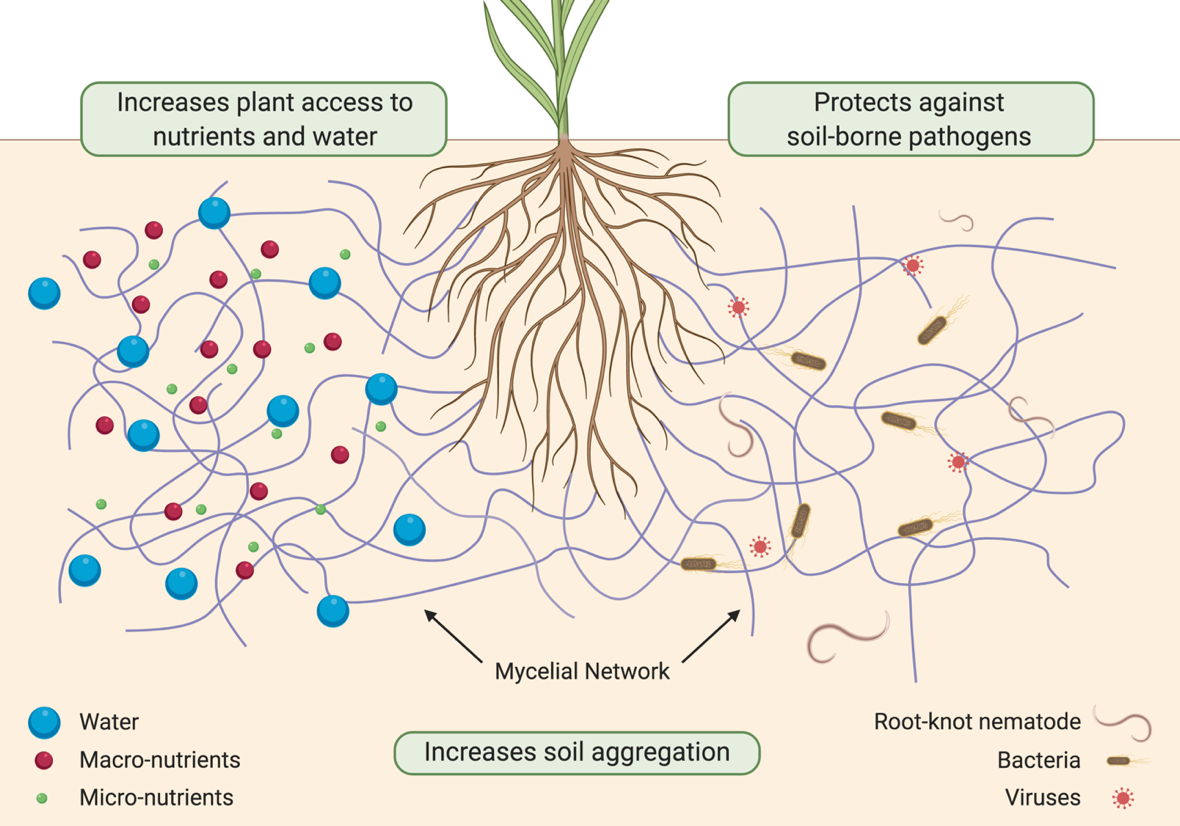Using cover crops to stimulate mycorrhization of grapevine
Cover crops stimulate the development of microbial communities such as arbuscular mycorrhizal fungi (AMF). In the BIOVINE project cover crops are tested to promote AMF communities associated with grapevine roots.

Micro-fauna and soil microbes actively participate to the dynamics of soil nutrients, as for example the mineralization of organic matter. Some microorganisms are forming mutualistic symbiosis with the roots of many annual and perennial plants. In vineyards, arbuscular mycorrhizal fungi (AMF), are able to colonize the roots of grapevine as well as the roots of more than 80 percent of land plants; they probably form the most prevalent and oldest symbiosis, the arbuscular mycorrhizal symbiosis, that appeared perhaps 450 million years ago, when plants plants from water ecosystems colonized land. In vineyards, AMF provide multiple ecosystem services (Fig. 1) by improving plant growth and nutrition, soil structure, tolerance to abiotic stresses as well as to soil-borne pathogens. Mycelial network, formed by AMF hyphae, explore a soil volume at least 40 times more important than plant roots, allowing a better access to water and soil nutrients (e.g. phosphorus, nitrogen). In addition, Mycelial network is linking the roots of grapevine and cover plants, allowing exchanges of nutrients and information.
In a vineyard, the mycorrhizal team of UMR Agroecology (INRAE Bourgogne Franche-Comté, University of Burgundy) aims to identify a wide range of plant species (spontaneous grassing, green manure, sowed cover) that could provide beneficial effects on grapevine through AMF.
In the first part of the BIOVINE project, 59 plant species were selected; both cover crops generally used in agriculture and common weeds. Their ability to form AM symbiosis was evaluated under controlled conditions using one AMF. First results show that the level of AMF root colonization depends on plant species and plant families. Interestingly, some common weeds are better colonized compared to cover crops, suggesting these plants could be a reservoir of AMF diversity in the vineyard and with which the grapevine could interact during its developmental cycle and benefit from their services.
Research groups participating to the BIOVINE project have established experimental plots including new viticultural systems based on ecosystems services provided by cover plant species: the development of arthropods, the control of soil-borne pests (oomycetes, fungi, nematodes) and foliar pathogens, and the promotion of AM symbiosis. In this context, the UMR Agroecology analyse the diversity of AMF communities associated both to cover plants and grapevine.
| FACT Box |
|---|
| Biovine partners sampled cover crops and grapevine roots (Fig. below) at different stages of grapevine development. Cover crop root system was carefully dug out from the soil to keep it intact, washed, and stored in plastic bags at 4 ºC until DNA is extracted. In 2020, root colonization of 39 cover crops and 22 grapevine root samples was estimated. DNA from all samples was extracted and AMF diversity was assessed by sequencing a fragment of the large ribosomal sub-unit. |
Grapevine roots sampled in France |
BIOVINE project website, www.biovine.eu
Gianinazzi S., Gollotte A., Binet MN., van Tuinen D., Redecker D. and Wipf D. 2010. Agroecology: the key role of arbuscular mycorrhiza in ecosystem services. Mycorrhiza.
doi.org/10.1007/s00572-010-0333-3.
Trouvelot S., Bonneau L., Redecker D., van Tuinen D., Adrian M. and Wipf D. 2015. Arbuscular mycorrhiza symbiosis in viticulture: a review. Agronomy for Sustainable Development.
doi.org/10.1007/s13593-015-0329-7
Drain A., Bonneau L., Recorbet G., van Tuinen D., Wipf D. and Courty PE. 2019. Characterization of Arbuscular Mycorrhizal Communities in Roots of Vineyard Plants. Methods in Rhizosphere Biology Research.
doi.org/10.1007/978-981-13-5767-1_3
Wipf D., Krajinski F., van Tuinen D., Recorbet G. and Courty PE. 2019. Trading on the arbuscular mycorrhiza market: from arbuscules to common mycorrhizal networks. New Phytologist.
Noceto PA., Hériché M., Fromentin J., Rossi V., Širca S., Ranca A., Kehrli P., Armengol J., Trouvelot S., van Tuinen D., Courty PE. and Wipf D. 2020. Les couverts végétaux : un atout majeur pour réduire les intrants de synthèse et augmenter les services écosystémiques au vignoble. La Revue des Œnologues n°175
Authors
Pierre-Antoine Noceto, UMR Agroécologie, AgroSup Dijon, CNRS, Université de Bourgogne, INRAE, Université de Bourgogne Franche-Comté. pierreantoine.noceto@inrae.fr
Jérôme Fromentin, UMR Agroécologie, AgroSup Dijon, CNRS, Université de Bourgogne, INRAE, Université de Bourgogne Franche-Comté. jerome.fromentin@inrae.fr
Diederik van Tuinen, UMR Agroécologie, AgroSup Dijon, CNRS, Université de Bourgogne, INRAE, Université de Bourgogne Franche-Comté. diederik.van-tuinen@inrae.fr
Pierre-Emmanuel Courty, UMR Agroécologie, AgroSup Dijon, CNRS, Université de Bourgogne, INRAE, Université de Bourgogne Franche-Comté. pierre-emmanuel.courty@inrae.fr
Daniel Wipf, UMR Agroécologie, AgroSup Dijon, CNRS, Université de Bourgogne, INRAE, Université de Bourgogne Franche-Comté. daniel.wipf@u-bourgogne.fr
Editor: Karin Ullven / Design: Christine Dilling

